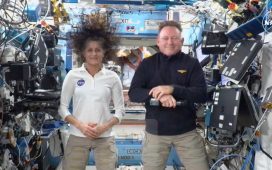A parade of seven planets will appear in the night sky on February 28, creating a striking display that won’t be seen again until 2040.
The planetary alignment occurs when several planets all appear on the same side of the sun and while it is not uncommon for up to five to move together, the upcoming event occurs every few years.
Mars, Jupiter, Uranus, Venus, Neptune, Mercury and Saturn will form a line shortly after sunset that Friday evening.
Astronomers said most planets will be brighter than nearby stars, making them visible to the naked eye.
However, Uranus and Neptune should require binoculars or a telescope to see due to their distance from Earth.
All of the planets except for Mercury have already fallen into alignment, making a parade of six, and the small planet is set to join on the evening of February 28 to complete the cosmic event.
The best time to see the parade will be just after sunset when the stars first appear in the sky, but you’ll only have a couple of hours before Venus, Saturn and Neptune dip below the horizon.
Choosing a dark, rural viewing location far away from city lights or other sources of light pollution will help the planets appear brighter.

Planetary alignments occur when several planets all appear on the same side of the sun. This file photo shows an exaggerated view of the lineup
There is one light source that will be unavoidable: the moon. But fortunately, it will be in its darkest phase on February 28 and should not blot out the planetary parade.
Make sure your eyes have plenty of time to adjust to the darkness and you have an unobstructed view of the horizon, as Mercury and Saturn will appear close to that line.
In a sky full of stars, the planets can be identified by their distinct lack of twinkling (stars twinkle, while planets usually shine steadily).
Telling the planets apart with the naked eye is relatively simple to do, according to Jake Foster, an astronomy education officer at Royal Museums Greenwich.
‘Venus will be noticeably the brightest of all four planets, shining a bright white light, and Jupiter will be the second brightest, also shining white in color,’ he previously told MailOnline.
Venus is also known as ‘the Evening Star’ or ‘the Morning Star’ because it is the brightest celestial object in the night sky, apart from the moon.
‘Saturn will be clearly fainter than the other three, due to its much further distance from the sun,’ Foster said.
This planet has a pale yellow hue due to ammonia crystals in its upper atmosphere.

The conjunction of planets Venus (top) and Jupiter in the sky above Salgotarjan, Hungary, March 2, 2023. Venus appears brighter because it is closer to Earth

Skywatchers will need binoculars or a telescope to see Uranus and Neptune on Feb. 28
‘Mars will have the most distinctive difference from the others because of its coloration, appearing as a bright orange point of light to the naked eye,’ Foster added.
The Red Planet will appear furthest to the east.
Venus and Saturn will be in conjunction, meaning they will appear closest to each other, while Jupiter, Mars and Uranus will appear further east.
Jupiter, the largest planet, has a light tan color and outshines everything except Venus.
Neptune will be close to Venus and Saturn — but remember you will need a telescope or binoculars to see Neptune and Uranus.
‘Uranus and Neptune, two very distant ice giant planets out in our solar system, are also there in the sky, but they are very faint,’ Preston Dyches, expert at NASA Jet Propulsion Laboratory, told ABC News.
A telescope with at least an eight-inch aperture at 50 times magnification is needed to see Uranus and its rings. To see Neptune, keep the same aperture but increase the magnification to 150.
Uranus will be slightly easier to spot than Neptune because it is noticeably brighter and can be found in darker skies.
Planetary alignments occur when several planets all appear on the same side of the sun, as viewed from Earth.
This makes it appear that all the planets are arranged in a long diagonal line stretching from east to south across the night sky.
During an alignment, they look closer to Earth when viewed from our planet, but they are still millions of miles apart during an alignment.
They only appear to move closer, or farther apart, in the sky as our vantage point changes from month to month.
What’s more, just because the planets look aligned from out viewpoint doesn’t mean they are actually in that formation out in space.
‘Alignment is therefore an artefact of a viewpoint and not something fundamental about the planets themselves,’ said Dr Christopher S. Baird, assistant professor of physics at West Texas A&M University.
Baird also said that planets in our solar system never line up in one perfectly straight line ‘like they show in the movies’.
‘If you look at a two-dimensional plot of the planets and their orbits on a piece of paper you may be led to believe that all the planets will circle around to the same line eventually,’ he added.
‘In reality, the planets do not all orbit perfectly in the same plane.
‘Instead, they swing about on different orbits in three dimensional space. For this reason, they will never be perfectly aligned.’
Still, being able to see multiple planets lined up across the night sky is an unusual treat.
‘Often planets will rise as others have set, but it is fairly rare for multiple planets to be visible simultaneously,’ Royal Observatory Greenwich astronomer Finn Burridge previously told MailOnline.
‘Some parades may only include three or four planets, this year we have six, which is very rare and quite significant.’
Those six planets have been in parade formation since mid-January. But the addition of Mercury on February 28 will make this an even rarer spectacle: a parade of all seven non-Earth planets in our solar system.
This won’t happen again for another 15 years.














